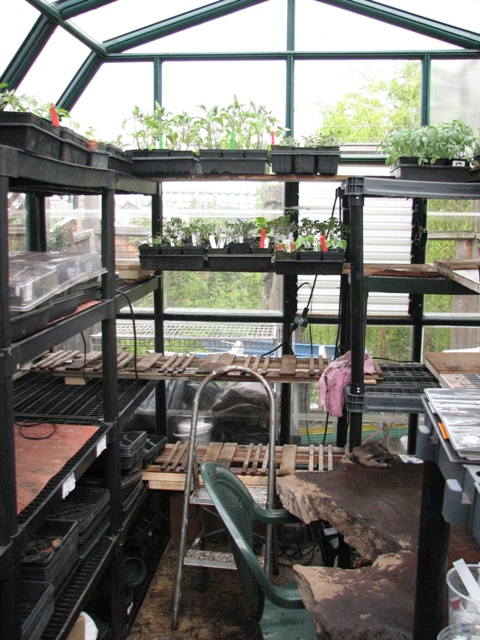Growing Food, Growing Community (GFGC) is the product of a motivated group of neighborhood volunteers who wanted to put a backyard greenhouse to good use. Over the past few years, they have connected with Lettuce Link to grow high-quality plant starts for P-Patch food bank gardeners. In 2011, they provided approximately 5,000 starts to P-Patch food bank gardens, community gardens, and low-income gardeners.
 Where to grow
Where to grow
Although GFGC is a community effort, it is only possible with the enthusiastic support of Cyrus Appell, who owns the greenhouse and therefore stores much of the equipment, allows unrestricted daytime access to his yard for 2-3 volunteers each day, and fronts the water and electricity costs the greenhouse incurs.
That said, there are many potential locations for a similar project. In addition to private residences, many schools have greenhouses. You could fundraise to build a greenhouse on the property of a community organization or garden, church, etc. You could even invest in fluorescent lights and grow starts indoors!
What to grow
In determining what to grow, it’s important to keep in mind the preferences of food bank clients, food banks, and the gardeners who will be growing the food. Early in the season, Lettuce Link surveyed P-Patch giving gardeners to see what starts they wanted and used the relative popularity of each request to guide the goals of GFGC. See the P-Patch Growing & Giving section for more recommendations.
Volunteers
There are two levels of involvement in GFGC:
Managers – this group of 5-7 volunteers oversees planning, fundraising, and day-to-day operations. Each manager is assigned one day of the week to check in on the greenhouse. He/she makes sure that plants are watered and fertilized as needed, sets to-dos for daily volunteers, and checks in with and updates the other managers as needed. The managers group also takes care of:
-
Recruiting volunteers
-
Sending a weekly email update
-
Holding a volunteer training at the beginning of the season
-
Organizing volunteer potlucks throughout the season
-
Communicating with the other managers
Daily volunteers – each daily volunteer is assigned one day of the week to work in the greenhouse, with 2-3 volunteers assigned to each day. They can work independently or arrange a time to meet (though the greenhouse can only comfortably hold two people). With a general guideline of 1 hour/week, they are responsible for:
-
Seeding new trays
-
Transplanting seedlings to 4” pots
-
Watering and fertilizing as needed
-
Recording daily activities in the greenhouse journal and on the tracking sheet
-
Greenhouse maintenance
Distributing starts
In 2011, Lettuce Link took responsibility for distributing starts, and we found it worked best to set up a weekly system:
-
On Mondays, LL picked up all the starts that were ready and sent a notice to the listserv of P-Patch food bank gardeners.
-
Gardeners responded with what they wanted and whether they could pick them up or needed them delivered. Starts were set aside on a first-come, first-served basis.
-
LL staff packaged and labeled starts for pickup. Gardeners could come to get them at the Solid Ground office Tuesday through Friday.
-
On Thursday or Friday, LL staff delivered starts to gardens that couldn’t pick them up.
Recordkeeping
After surveying P-Patch gardeners, we were able to set goals and plan accordingly. By tracking how many trays we had seeded and/or transplanted as we went along, we were able to know when to stop and move onto another crop. We also learned:
-
Using 18-pot trays as a unit of measurement made it easier to keep things consistent.
-
We ended up with huge amounts of some crops after transplanting due to heavily seeded trays and not enough thinning.
Not all crops and varieties were equally popular. By taking notes along the way and soliciting feedback from gardeners at the end of the season, we learned which crops grew well, which ones failed to thrive, and how we could improve operations for next year.
Funding and Materials
Covering costs is a big concern for GFGC. In addition to repaying Cyrus for water and electricity expenses, the group also needs to pay for materials. We tried to mitigate these costs in several ways:
-
Gardeners that received starts were asked to return pots and trays once they had finished planting. By repeating this request in every announcement about starts, we achieved a very good return rate.
-
A local landscaping company donated enough pots and trays to meet most of our needs.
-
We put out a call for large yogurt containers and cut them into strips to use as labels. Once you’ve removed the bottom of the container, using a paper cutter to cut the strips made this task much less tedious.
-
Cedar Grove donated almost enough potting soil to cover all of our needs.
Of course, some fundraising was still necessary. One of the managers applied for a small grant from the City of Seattle, which we received. Another manager runs a small produce stand at her house and sold some of our extra starts for a suggested donation. This also proved to be a great outreach opportunity within the neighborhood.
Lessons Learned
Everybody likes plants. While working with the Wallingford Greenhouse, I noticed that anytime I went somewhere carrying a tray of plant starts, everyone wanted to talk to me! Some wanted to know what type of plants they were, some asked about the project, and others told me about their own gardens. Few could resist “petting” the plants, either. It was a great reminder that often times the interest may be there, but it takes something extra to spark a conversation.

 Where to grow
Where to grow